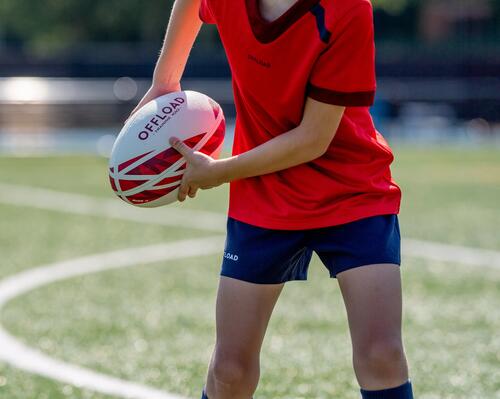Like all forms of rugby, touch has its own specific skills that are not seen elsewhere. We're going to tell you all about them:
TOUCH The touch, as explained above, is the act of touching the ball carrier or the ball itself to prevent them progressing up the pitch. The defending player making the touch should shout "touch" when they do so. Touches should not be performed with force as this will result in a penalty being awarded against the defending team. Touches can be made with one or both hands. When a ball carrier is touched, the player must perform a rollball by placing the ball on the ground at the point where the touch was made and rolling it back or stepping over it.
Teams have a set of six touches in which to score a try. When the fifth touch is made, the referee announces that the team in possession are on their final touch. When the sixth touch is made, possession is turned over to the other team. Two clarifications: if the ball carrier is touched in the act of scoring a try, the touch is awarded and the attacking team must start their next attack from the five-metre line. Also, if the ball carrier is touched and then passes the ball, the referee whistles for a “touch and pass” and possession is turned over to the opposing team.
ROLLBALL The rollball is a way of restarting play. It must be performed by when a ball carrier is touched by a member of the opposing team. The player who has been touched is required to do it. The rollball is performed on the ground, at the point where the touch was made. The opposing team must take up position a minimum of five metres from the restart.
When possession is turned over, the team taking possession must perform a rollball. Turnovers can occur for a number of reasons: when the ball touches the ground, when the player taking possession after a rollball (the dummy half) is touched, when the ball carrier goes into touch, or after a set of six touches
TAPBALL Play starts and restarts (after a try or a penalty) with a tapball. The rules on tapballs are very clear: The player must put the ball down on the ground in front of them, move it with their foot no more than a metre, and then pick it up. The defending team must retreat at least ten metres from the point where the tapball is taken.
Defending players cannot move until the player taking the tapball has touched the ball. Although the attacking team must relinquish possession if the dummy half is touched on receiving the ball, if the player taking the tapball is touched, their team do not lose possession.
PENALTIES As in other forms of rugby, there are penalties in touch rugby. When a penalty is awarded a tapball is taken. Penalties can be awarded for a number of reasons: a forward pass, a touch and pass, a rollball not taken in the exact position of the mark (where the touch was made) or any type of behaviour in breach of the rules of touch (using more than minimum force to make a touch, claiming a touch when none was made, etc). The penalty can result in the player committing the infringement being removed from the field of play for two minutes or sent off if the referee deems their behaviour to be aggressive.






